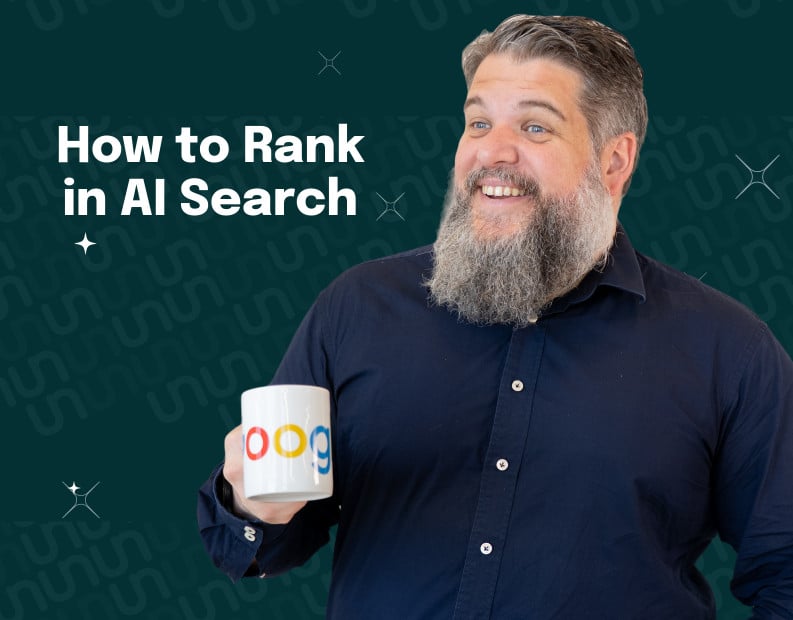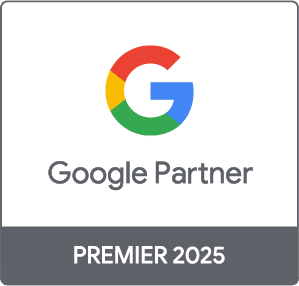It’s funny how quickly a background hum becomes the main event. For the last couple of years, AI has been this interesting, nerdy thing happening on the sidelines. I’ve been watching it, tracking it, and talking about its potential with my team. But in the last six months? The momentum has been staggering. It’s not a future concept anymore; it’s just… here.
I was queuing for a coffee the other day, and the person in front of me wasn’t tapping on their phone. They were talking to it. Not to a person, but to an AI. “Find me the best flat white near me that uses ethically sourced, single-origin beans and has oat milk that doesn’t suck.” I half expected the phone to sigh and say, “A bit demanding for 8 AM, aren’t we?”
But it just… answered. Perfectly. It gave a single, definitive answer with a map and a snippet from a review.
And this isn’t just a random observation anymore. It’s hitting our bottom line, in a good way. Just last week at our agency, Unbound, we had two separate leads come in. When we asked how they found us, the answer wasn’t “a Google search.” One found us after asking ChatGPT for the “best automotive digital agency nz.” Another was looking to “get help with cookie consent nz.”
For years, we’ve busted our guts to rank for those terms on Google. And it worked. But now, people are finding us through a conversation with a chatbot. That’s a seismic shift. If you’re in the business of getting found online, you’re either adapting or you’re about to become a digital fossil.
For years, I’ve made a living (and let’s be honest, lost a lot of sleep) mastering the beautiful, frustrating game of Google SEO. But the game has changed. We’re not just optimising for a search engine anymore. We’re optimising for an answer engine.
This is my guide on how to do it. Forget the jargon-filled nonsense from so-called gurus. This is the real-world, battle-tested stuff that’s working right now.
From SEO to AEO: The Great Shift
First, let’s get our heads straight. Traditional Search Engine Optimisation (SEO) was about convincing an algorithm your webpage was the most relevant result for a keyword. The goal? To get a click from a list of links.
That’s old news.
Now, we’re playing in the world of Answer Engine Optimisation (AEO) or Generative Engine Optimisation (GEO). The goal isn’t just to rank; it’s to be the source of the answer that the AI – be it Google’s AI Overviews, Gemini, Perplexity, or ChatGPT – provides directly to the user.
Why does this matter? Because for many queries, there is no click. The user gets their answer and moves on. Your content might be the source, giving you an “impression” or a “mention,” but the user never actually visits your site. It’s like being the ghostwriter for the world’s most popular book; you did the work, but someone else gets all the credit.
And while that sounds terrifying, there’s an upside. The clicks we do get from AI are gold dust. They are from users with much higher intent. They’ve had their basic query answered and now they’re clicking for deeper expertise, to buy, or to engage. These visitors are worth their weight in gold.
But how do you become that trusted, citable source in the first place?
Your New Religion: Making E-E-A-T Your Everything
If you take one thing from this article, let it be this: E-E-A-T is no longer a guideline; it’s the price of entry.
E-E-A-T stands for Experience, Expertise, Authoritativeness, and Trustworthiness. It’s the framework Google uses to fight misinformation, and it’s the absolute bedrock of how AIs determine which sources to trust. Let’s break it down with some no-fluff examples.
- Experience: This is the new kid on the block, and it’s a game-changer. AI doesn’t want content regurgitated from other websites. It wants content that proves you’ve actually done the thing you’re talking about.
- Bad: A generic article titled “5 Best Hiking Boots.”
- Good: An article titled “I Hiked the West Highland Way in These 5 Boots: Here’s What Survived.” See the difference? It’s about showcasing real-world use. Include your own photos, not stock images. Talk about how the boots felt after 20 miles in the pouring Scottish rain. Prove you were there.
- Expertise: This is about showing your credentials. Why should anyone, or any AI, listen to you?
- Bad: An article on financial advice written by “Admin.”
- Good: An article on financial advice written by “Jane Doe, a Chartered Financial Planner with 15 years of experience.” Your website needs clear author bios with qualifications, links to their social profiles, and a dedicated author page listing all their contributions.
- Authoritativeness: This is about your reputation. Are you recognised as a leader in your field?
- How to build it: This is the slow burn. It’s about getting other authoritative sites to link to you and mention you. Think digital PR. If you’re a legal firm, a link from a local university’s law school page is worth more than a thousand links from spammy directories. You need to be creating content so good that people want to cite it. This is where building a genuine brand becomes your ultimate SEO strategy. It’s not just about links anymore; it’s about being talked about. When your brand name appears in articles, podcasts, and social media, AI models notice. It’s a massive signal of authority. This is where online PR becomes your secret weapon. Getting your story and your expertise featured in the right places is critical. If that sounds daunting, talk to our friends at Brainchild – they are absolute wizards at getting brands talked about and building the kind of online presence that AIs love.
- Trustworthiness: This is the foundation. It’s the simple stuff we often overlook.
- The checklist: Do you have an easy-to-find contact page? A clear privacy policy? Do you cite your sources? Is your website secure with HTTPS? If you’re selling something, are your terms clear? An AI, like a savvy consumer, looks for these signals. It wants to know there are real, accountable humans behind the website.
Honestly, if you just spent the next six months obsessing over E-E-A-T, you’d be ahead of 90% of your competitors.
Structuring Content for an AI’s Brain
Okay, so your content is now oozing with E-E-A-T. Fantastic. But if it’s structured like a university dissertation, an AI will get bored and leave. You need to format your content so a machine can easily parse it and pull out direct answers.
- Use the Inverted Pyramid: Answer the question first, then provide the context. Don’t bury the lead. If your heading is “What is Topical Authority?”, the very first sentence should be “Topical authority is a measure of a website’s perceived expertise in a specific niche.” Simple. Direct.
- Ask and You Shall Receive (a Ranking): Structure your articles around questions. Use H2s and H3s that are literal questions your audience would ask (e.g., “How Do I Implement Schema Markup?”, “What Are the Best Tools for Keyword Research?”). This makes it ridiculously easy for an AI to grab your heading and your first paragraph as a perfect question-answer pair.
- Lists, Tables, and Bullet Points are Your Best Friends: AIs love structured data. If you’re comparing products, use a table. If you’re outlining steps, use a numbered list. It breaks up the text for human readers and makes the information easily digestible for machines. It’s a win-win.
- Embrace the FAQ: Have a Frequently Asked Questions section at the end of your key articles. Then, mark it up with FAQ schema. This is like spoon-feeding the AI exactly what it needs to generate rich snippets and answer related queries. It’s almost too easy.
- Weave Video into Everything: Video is no longer a “nice to have”; it’s a core part of modern marketing. AI models like Gemini are multi-modal, meaning they understand text, images, and video. Embedding relevant videos in your articles is a powerhouse move. It’s the ultimate way to demonstrate Experience – showing a product in use is infinitely more powerful than describing it. Video keeps people on your page longer, a huge engagement signal. And with AI now able to analyze and pull information from video transcripts and even visual cues, your video content becomes another citable source. Don’t just write a blog post; create a companion video and embed it.
The Nerdy Stuff: Technical SEO for AI Search
I know, I know. Just when you thought it was all about great writing, the technical gremlins appear. I’ll keep this brief, I promise. You don’t need to be a developer, but you do need to be aware of this stuff. Even me, a self-confessed word nerd, has had to get my hands dirty with this.
- Schema Markup is Your AI Translator: If E-E-A-T is what you say, Schema is the language you say it in. It’s a vocabulary of code you add to your site to tell search engines exactly what your content is about. You can specify that a piece of text is a
Person‘s name, that a number is aProduct‘sprice, and that an article was written by anauthorwhoworksFora specificOrganization. It’s the single most powerful technical thing you can do to make your site AI-ready. - Site Speed Isn’t a suggestion, it is a requirement. AIs, like impatient humans, don’t wait around for slow websites. If your site takes more than a couple of seconds to load, you’re out. Test your site with Google’s PageSpeed Insights and fix what it tells you to.
- Build a Knowledge Graph with Internal Links: Link your articles together logically. If you have a main “pillar” page about “Digital Marketing,” it should link out to all your smaller articles on “SEO,” “PPC,” and “Content Marketing.” And those smaller articles should link back to the pillar page. This creates a web of interconnected knowledge that proves your topical authority on a subject. It shows the AI you haven’t just written one random article; you own the entire topic.
Is it a lot to take in? Maybe. But can you really afford to ignore it, especially when your competitors are probably already on it? It’s like that whole “crypto” thing a few years back; everyone was talking about it, but only the ones who actually dug in and understood it saw the real benefits. This is that moment for SEO.
Look, at the end of the day, optimising for AI is about being more human. It’s about creating genuinely useful, expert-driven, and easy-to-understand content. The machines have just gotten incredibly good at telling the difference between the real deal and the rubbish. For a long time, we SEOs got away with a few tricks and shortcuts. That party is well and truly over.
It’s about quality. It’s about authority. And most of all, it’s about proving you know your stuff.
Now, I want to hear from you. What’s the single most surprising way AI has changed how you think about your website?






